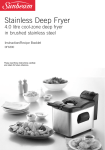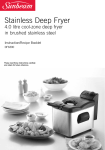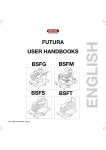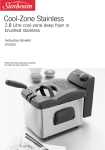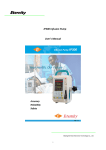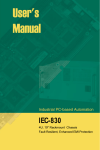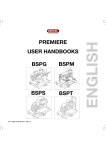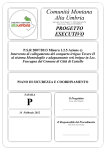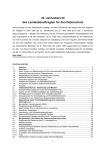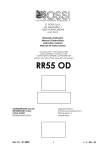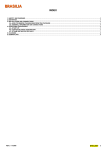Download UM - EN - REV 0.X3 - User Manual AVANTGARDE
Transcript
ENGLISH USER HANDBOOKS BSAG UM - CODE - REV 0.X3 ENGLISH AVANTGARDE Introduction Thank you for having purchased one of our products, we recommend that you read our manual carefully before using the slicing machine. Regarding safety against mechanical risks, the machines described in this manual follow the directive regulations 98/37/EEC - 73/23/EEC - 89/336/EEC and the European norms EN 1974: slicing machines - hygiene and security norms. We are at your complete disposal for any concerns that may arise when using the machine, for more information, and any proposals to improve this manual so that it can further meet the requirements for which it has been prepared. UM - CODE - REV 0.X3 ENGLISH Safety precautions In the interests of your own safety and for the care of your slicer, please take note of the following points: As an employer Instruct your personnel in the use of the slicer and draw their attention to the safety precautions, repeat this periodically and keep this manual near your slicer for reference. Who may operate the slicer? Only properly trained and instructed personnel may operate the slicer. Only Berkel - or authorised service engineers may rectify any faults. No access for unauthorised persons! Ensure that unauthorised persons and those who have not received any instruction do not operate or clean the slicer. Authority to remove components You are only authorised to remove the removable parts from the slicer, see the chapter " Cleaning the slicing machine". You are not authorised to remove the remaining components and you are never authorised to distort or bend components. Slicing products Only use the slicer with those products for which it is designed, such as meat, cooked meats and cheese. Do not use to slice frozen products, products on the bone or non-food products. Slicing Always follow the slicing instructions carefully, see the chapter on " Loading the goods on the plate and cutting". The knife Always remember that the knife is very sharp and therefore dangerous, even when the knife is stationary. Do not operate the slicer thoughtlessly and never touch the cutting edge of the knife with your hand or fingers. Sharpening the knife Particular care should be exercised when sharpening the knife. First read the instructions in the section entitled " Sharpening the blade" and follow these instructions carefully. Avoid the area of the knife, especially with your hands. Avoid touching the knife, even when the slicer is switched off, other than to clean it safely. Thickness dial Get into the habit of working as follows: only turn the thickness dial (knob) away from its safe setting when you are ready to begin slicing; in other words, after you have placed the goods to be sliced on the meat table. Always turn the thickness dial (knob) back to the safe position to reposition the product on the meat table or remove it. UM - CODE - REV 0.X3 3 4 Safety precautions Turn thickness dial (knob) right back to safe position - clockwise After slicing always reset the thickness dial (knob) right back to the safe position first and then switch the slicer off. Dependent on the slicer setting, please be sure that the dial (knob) is turned all the way back to its safe position. Exercise particular caution when removing product scraps from the meat table . Only do this once the thickness dial (knob) has been reset to its safe position and the slicer has been switched off. Connection to mains Check whether the mains voltage matches that given on the slicer (see the data plate on the side of the machines casing). A qualified electrician may only connect “400 Volt three-phase” current slicers. Connection to the incorrect mains voltage can seriously damage the slicer. What to do in the event of a malfunction Switch the slicer off immediately if you hear and/or notice anything unusual. Check in the section " Locating and eliminating failures” to see if you can rectify the fault yourself. If not, contact your local authorised service agent. RSI (Repetitive Strain Injuries) Continuous use of a slicer may cause Repetitive Strain Injuries or related injuries. Some studies suggest that long periods of repetitive motion coupled with an improper working environment and incorrect work habits may be linked to certain types of physical discomfort or injury. If you feel any aching, numbing, or tingling in your neck, shoulders, arms, wrists, hands, or fingers, consult a qualified health professional. These suggestions can help to reduce your risk of RSI: - Take frequent breaks from use; - Be sure to change posture frequently; - Stand on an anti-fatigue mat or use a standing support to reduce fatigue; - Keep your hands, forearm and wrists straight and curl your fingers under slightly; - Set up your workspace. Cleaning the slicer Only allow staff who have received appropriate instruction to clean the slicer. Proceed as follows: - Reset the thickness dial (knob) to its safe position - Switch the slicer off - Remove the mains plug from the wall socket - Do not use any aggressive and/or abrasive cleaning agents - do not use any steam or high-pressure cleaners - Clean the slicer thoroughly especially pointed, sharp and round components. Careless cleaning can be dangerous for yourself and may invalidate the terms of the guarantee. Environment Keep your work place clean and dry, then you will always have a safe environment. Workplace Ensure that the slicer is installed in stable fashion on a solid work surface. Check yourself that there is no danger of the slicer sliding or falling. Ensure that there is sufficient space around the slicer and keep the workplace clean and orderly. Do not use the slicer as a storage area. Place nothing on it which does not belong there. Transport Remember that the slicer is very heavy. The slicer must always be moved by at least two people. Always seek the assistance of colleagues when moving the machine. UM - CODE - REV 0.X3 ENGLISH Contents 1. Premise 1.1. Purpose of the manual ............................................................................................................................................................................................ 1.2. Keeping the manual ................................................................................................................................................................................................ 1.3. Use of the machine ................................................................................................................................................................................................. 2. General information 2.1. Machine limits, safety regulations .............................................................................................................................................................................. 2.2. Guarantee and manufacturer’s responsibility .............................................................................................................................................................. 2.3. The user’s obligations .............................................................................................................................................................................................. 2.4. Marking-plates ........................................................................................................................................................................................................ 3. Technical characteristics 3.1. Dimensions, BSAG series ........................................................................................................................................................................................ 3.2. Specifications, BSAG series ..................................................................................................................................................................................... 3.3. Supplied items and accessories ............................................................................................................................................................................... 3.4. Products that can be sliced ..................................................................................................................................................................................... 3.5. Products that cannot be sliced ................................................................................................................................................................................. 4. Description 4.1. Unpacking .............................................................................................................................................................................................................. 4.2. Main components ................................................................................................................................................................................................... 4.3. General description ................................................................................................................................................................................................. 5. Installation 5.1. Installing the machine .............................................................................................................................................................................................. 5.2. Command description ............................................................................................................................................................................................. 5.3. Electrical connection ............................................................................................................................................................................................... 5.4. Checking direction of rotation of the blade (only for machines with three-phase motors) ................................................................................................. 6. Using the machine 6.1. Loading the goods on the meat table and slicing ...................................................................................................................................................... 6.2. Cleaning the slicing machine .................................................................................................................................................................................... 7. Maintenance and repairs 7.1. General information ................................................................................................................................................................................................. 7.2. Sharpening the blade .............................................................................................................................................................................................. 7.3. Lubricating the meat table and the pusher plate assembly slide bars ............................................................................................................................ 8. Locating and eliminating faults ...................................................................................................................................................................................... 9 . Electrical diagram ......................................................................................................................................................................................................... 10. Dismantling the slicing machine .................................................................................................................................................................................... UM - CODE - REV 0.X3 5 6 1. Premise 1.1. Purpose of the manual This publication contains all the information necessary for the use and maintenance of the slicing machines to be used for food, with circular blade, models BSAG (Avantgarde gravity slicers). The purpose of this manual is to allow the user, above all the direct user, to take every precaution and arrange all human and material means necessary for a safe and lengthy use of these machines. 1.2. Keeping the manual This manual must be given to the person who will use and maintain the machines and this person should keep the manual in a safe and dry place, ready to be used. We recommend that a copy be kept on file. For any correspondance with the maker or authorized personnel, please refer to the information on the data plate (located on the side of the machines casing) and the machine serial number. The manual must be kept for the entire life of the machine and in case of need (ex. any damage to even a part of the manual that makes consulting it difficult) the user must acquire a new copy exclusively from the manufacturer. The user must let the manufacturer know the address of any new owner of the machine. NOTE: The terms Front, Back, Right and Left used in this manual refer to the machine as seen from the operator’s side in normal working conditions. 1.3. Use of the machine The use and configurations of the machine are the only ones allowed by the manufacturer; do not try to use the machine differently from the instructions. The use of the machine is only valid for machines with a complete structural, mechanical and system integrity. The machines are to be used for cutting only food products of the type and size indicated in this manual. The manufacturer declines all responsibility derived from an improper use or use by untrained personnel, changes and/or repairs carried out by one’s own or by unauthorized personnel, and the use of spare parts that are not original or not specific for the type of machine. For any explanation or concerns on the contents of this manual, please contact immediately the manufacturer or authorized technical assistance and quote the relevant paragraph number from this manual. UM - CODE - REV 0.X3 ENGLISH 2. General information 2.1. Machine limits, safety regulations The machine has been designed and made to slice food products, with a continuous service, of the type and size as indicated in paragraphs 3.2, 3.4 and 3.5. 2.1.1. Environmental conditions for using the machine - Temperature; from -5°c to +40°c - Humidity max; 95% The slicer cannot be used outside of a building or structure. It cannot be used in rooms with steam, fumes or corrosive and/or abrasive dusts where fire or explosion risk are present and anywhere where anti-deflagration components are used. 2.1.2. General safety regulations The slicing machine must be used only by an adequately trained person who has carefully read the contents of this manual. The operators must be over 18 years of age, in good mental-physical health, have the right attitude, capacity and necessary knowledge for the use and simple maintenance of mechanical and electrical products. For safe and successful use of the machine follow the instructions below: - Install the machine according to the instructions in the paragraph ”Installation”. Install the machine so that it is away from people who must not use it, especially children. Do not become distracted whilst using the machine. Do not wear loose clothing or open sleeves. Do not let anyone come close to the machine while in use. Do not remove, cover or change the meat tables that are on the machine and, if they are damaged contact qualified and authorised personnel. Do not remove the transparent meat table guard and do not change or exclude any mechanical or electrical safety devices Only slice permitted products; do not try slicing any products that are not allowed. The area around the machine, where the food is laid out and the floor where the operator works, must always be kept clean and dry. Do not use the machine as a support surface and do not place any object on it that does not pertain to normal cutting operations. Do not use the slicing machine when, after a normal use, the distance between the cutting edge of the blade and the blade protection ring is over 6 mm, (see paragraph 7.2). Do not use the machine with electrical connections of a ”temporary” nature, (with temporary or not insulated wires) Periodically check the state of the mains cable and the cable gland on the machine body, when necessary have it replaced without delay by qualified personnel Immediately stop the machine in the case of a defect, unusual function, suspected breakage, incorrect movements, or an unusual noise. Before cleaning or carrying out any maintenance, disconnect the machine from the electric mains supply. Use protective gloves for cleaning and maintenance. The goods to be cut must be placed on and removed from the meat table with the carriage in a retracted position, (to the front of the machine) and the thickness regulating knob in its safe position. Only use the handle of the meat table support for moving the meat table during slicing. The use of accessories for slicing are not permitted unless supplied by the manufacturer specifically for the machine. For any exceptional maintenance (replacing grindstones, blade, etc.) please contact the manufacturer or qualified and authorized personnel. UM - CODE - REV 0.X3 7 8 2.2. Guarantee and manufacturer’s responsibility The guarantee of good function and complete conformity of the machines, is wholly dependent up on the correct use and application of the instructions contained in this manual. The manufacturer declines all direct and indirect responsibility deriving from: - Not following the instructions in the manual. - Using the machine by personnel who has not read or well understood the contents of the present manual. - Using the machine so that it does not conform to specific regulations in force in the country of installation. - Unauthorized changes and/or repairs to the machine. - The use of accessories and spare parts that are not original, or supplied by the manufacturer - Outstanding events. If the machine is sold or given away, this automatically means that the manufacturer is no longer responsible for the machine in question except for anything regarding to the EEC directive 98/37 (responsibility for any construction faults of the product). 2.3. The user’s obligations The user must scrupulously observe the instructions in this manual for the manufacturer’s guarantee to be valid and particularly: - Always respect the limits of the machine; - Always carry out constant and diligent maintenance - Make sure the persons using the machine are qualified and able. 2.4. Marking — Plates (data plates) The following data plates are installed on the machine: - Manufacturer’s identification plate, machine plate, technical data plate and EC marking, placed on the left hand side of the base. UM - CODE - REV 0.X3 ENGLISH 3. Technical characteristics 3.1. Dimensions, BSAG series Models A B C D E F G H I L M BSAG (0°) 295 mm 229 mm 261 mm 588 mm 428 mm 649 mm 505 mm 460 mm 735 mm 880 mm 664 mm BSAG (7°) 302 mm 204 mm 248 mm 588 mm 428 mm 649 mm 505 mm 460 mm 734 mm 879 mm 664 mm BSAG (25°) 300 mm 153 mm 228 mm 588 mm 428 mm 649 mm 491 mm 460 mm 730 mm 807 mm 625 mm BSAG (0°) 261 mm 295 x 229h mm 32 mm 330 mm 0,37 kW / 230 V 50 Hz 1 phase 0,37 kW / 400 V 50 Hz 3 phases 550 x 430 mm 55 kg BSAG (7°) 248 mm 302 x 204h mm 32 mm 330 mm 0,37 kW / 230 V 50 Hz 1 phase 0,37 kW / 400 V 50 Hz 3 phases 550 x 430 mm 56 kg BSAG (25°) 228 mm 300 x 153h mm 32 mm 330 mm 0,37 kW / 230 V 50 Hz 1 phase 0,37 kW / 400 V 50 Hz 3 phases 550 x 430 mm 58 kg 3.2 Specifications, BSFG series Models Capacity (round) Capacity (rectangle) Maximum slice thickness Knife diameter Motor rating/Electrical specifications Base dimensions Net weight UM - CODE - REV 0.X3 9 ENGLISH 10 3.3. Supplied items and accessories The following documents and accessories are supplied with the machine, unless otherwise specified: - Instruction manual for use and maintenance. - EC conformity declaration. - Accessories: lubricating oil for carriage guide bars and pusher pin plate and on request (optional) tool for removing the blade. 3.4. Products that can be sliced The following products can be sliced: - All types of cold cuts (cooked, fresh, smoked and cured). - Boneless meat (cooked or fresh at a temperature of no lower than +3 °C). - Bread and cheeses (those that can be sliced, such as Gryere, Fontina, etc.). 3.5. Products that cannot be sliced The following are products that cannot be sliced because they could cause damage to the machine, and injury to people: - Frozen food. - Deep-frozen food. - Food with bones (meat and fish). - Vegetables. - Any other product not meant for consumption (non food products). 4. Description 4.1. Unpacking Check that the packaging is unopened and undamaged; otherwise immediately inform the forwarding agent or the area agent. To take the machine out of the packaging proceed as follows: WARNING: The packaging components (plastic straps, cardboard, polyurethane foam) can be thrown away with normal solid wastes and therefore there is no difficulty in disposing of them. However it is advisable to dispose of individual items of the packaging separately, in conformity with the regulations in force for adequate recycling. DO NOT DISCARD THE PACKAGING PRODUCTS IN THE ENVIRONMENT! 1. Cut and remove the plastic straps; 2. Remove the staples from the top of the box; UM - CODE - REV 0.X3 3. Open the box and take out the copy of the instruction manual which is on top of the internal packing; 4. Continue as indicated in the manual; 5. Push the upper cardboard box upwards (1) using the flaps so that the next step is easier, 1 WARNING: check that the blade is not exposed! 6. Lift and take out the internal box containing the slicer meat table; 7. Using a screwdriver, unscrew the 3 grub screws that secure the slicer to the pallet 8. Lift out the machine which is wrapped in a sheet of transparent polyethylene from the box ATTENTION: The machine must be lifted by two people, taking into account that it weighs more on the side where the blade is. 8. Once this operation is over, check the contents of the box and make sure it corresponds to the label on the outside box UM - CODE - REV 0.X3 11 ENGLISH 12 4.2. Main components BSAG series 1. 2. 3. 4. 5. 6. 7. 8. 9. 10. 11. 12. 13. 14. 15. 16. 17. 18. 19. 20. STOP BUTTON (RED) START BUTTON (WHITE) IDENTIFICATION PLATE, TECHNICAL DATA AND EC MARKING BASE FOOT REGULATING KNOB FOR SLICE THICKNESS THICKNESS PLATE (GAUGE PLATE) MEAT TABLE HANDLE MEAT TABLE SAFETY GUARD MEAT TABLE PUSHER PLATE HANDLE BLADE SAFETY RING (BLADE PROTECTION) SHARPENER COVER SLICE DEFLECTOR MEAT TABLE LOCKING LEVER MEAT TABLE SUPPORT ELECTRICAL CABLE PUSHER PLATE ASSEMBLY BLADE COVER UM - CODE - REV 0.X3 ENGLISH 4.3. General description The slicing machine has been designed and made according to the EEC directive 98/37 - 73/23 - 89/336 and the European norm EN 1974-1998. The machine offers the user: - Maximum security when in use, during cleaning and ordinary maintenance; - Maximum hygiene from the use of non corrodible materials and adequate protection against corrosion, together with a careful design of all the parts that come into contact with food; - Maximum cutting precision and capacity together with sturdiness and reliability of the structure; - The chance to work continuously. The machine is essentially made up of a base that holds a circular blade that is vertically mounted or inclined, operated by an electric motor, which slices the food. The carriage slides on bars, which is mounted on the base, the carriage in turn supports the meat table, which runs parallel to the cutting edge of the blade. The meat table , which in the vertical models is made up of a table and a sliding over table, this also has a device to keep the product in its proper place during cutting operations (pusher plate assembly). The thickness of the slice is regulated by a thickness (gauge) plate parallel to the blade, this plate on which the food is placed, can be moved away from the blade, setting the desired thickness of the slice. All the components of the machine are made of a light aluminium alloy and magnesium Peraluman 3, polished and anodized, in stainless steel and plastic (approved for food products) according to the sanitary regulations in force, so the structure is sturdy, reliable, easy to clean and does not distort over time. The cutting blade is operated by a self-ventilated motor, (under the base), the motor transmission is obtained with a belt that has longitudinal grooves, guaranteeing quiet running. Starting and stopping of the motor is carried out by using the two buttons at the front of the machine, which are easily identifiable by their colour and position, there is a light which indicates the machine is running. This command system prevents accidental starting of the machine after a possible electric circuit interruption, this means the slicing machine can only be restarted unintentionally. The machine has a sharpener which is extremely easy and safe to use. The meat table (with the safety transparent guard) , sharpener, pusher pin plate and blade cover can be removed for cleaning. 4.3.1. Safety The mechanical safety devices are the following: - No removable safety ring around the blade (ring guard blade protection); - Meat table which can only be removed if the regulating knob of the thickness plate is in the safe position and the carriage is at the end of its run, towards the operator’s end; Once the meat table has been removed the thickness (gauge) plate is locked in the safe position. The electric safety devices are the following: - Start-up with start and stop buttons, with a low voltage control circuit that also requires a voluntary re-start of the machine in the case of an electric circuit interruption; - Safety microswitch (on the low voltage auxiliary control circuit), which excludes any possibility of starting the electric motor without the blade cover being fitted in its correct place 4.3.2. Residual risks WARNING: The safety ring around the blade is made according to the European regulation (EN 1974:1998) but this protection does not completely eliminate risks in the sharpening area. When cleaning and sharpening the blade, be very careful and always concentrate on the job at hand. We recommend the use of protective gloves. 4.3.3. Ergonomics To avoid the risk of RSI (Repetitive Strain Injury) it is important to ensure that the machine is placed on a surface which is ergonomically satisfactory to the user. It is recommended that frequent breaks are taken during prolonged usage. UM - CODE - REV 0.X3 13 14 5. Installation 5.1. Installing the machine 5.3. Electrical connection Install the machine on a surface which is level, smooth, dry and suitable for the weight of the machine plus the food to be sliced; refer to paragraph 3.1. The machine must be installed close to an EEC regulation socket in a system which conforms to the regulations in force with: - Magnetothermal protection; - Automatic differential switch; - Grounding system. WARNING: Check that there is nothing that can get in the way of the plate and the food that is to be cut on the plate. MAX. HEIGHT: 0,90 m 5.2. Command description Before connecting, verify that the electric supply mains supply is suitable for the machine by checking the technical data plate on the machine. The slicer is fitted with a power supply cord of about 2 metres length, complete with a plug to allow a simple connection from the electric mains supply. Always indicate the presence of the power supply cord if the slicer cannot be installed near a socket and if in the installation zone there is a movement of people. If the power supply cord is not long enough you will require the assistance of authorised technical personnel, do not proceed with a temporary electrical connection. 5.2.1. Start and stop buttons - Press the GREEN button (2) to start the blade; - Press the RED button (1) to stop the blade moving. 5.4. Checking direction of rotation of the blade (only for machines with three-phase motors) 1. Start the machine; 5.2.2. Regulating knob for slice thickness The thickness of the slice is regulated by turning the graduated scale knob (3) counterclockwise. Regulating field: see paragraph 3. UM - CODE - REV 0.X3 2. Check the working light is on. 3. Check the blade rotates in the direction indicated by the arrow (counterclockwise looking at the machine from the side of the blade cover); 4. If the blade goes round in the opposite direction (clockwise) stop the machine immediately and call a qualified person to invert the feed wires of the plug; 5. Check the meat table and pusher plate assembly move smoothly; 6. Check the working and regulation of the thickness (gauge) plate knob ENGLISH 6. Using the slicing machine 6.1. Loading the goods on the meat table and slicing BSAG series slicing machines 1. Ensure the thickness regulator knob is turned back to its SAFE position, thickness (gauge) plate is fully closed; 2. Check that the machine is switched off. Pull back the carriage completely (towards the operator) to the loading position. 3. Lift up the pusher plate assembly and put it in the park position. 4. Place the meat to be sliced on the met table against the operator’s side of the meat table upstand Position the food product to rest against the gauge plate; 5. Set the thickness of the slice by turning the slice thickness knob anticlockwise, until the correct thickness is reached Start the blade by pressing the GREEN button. Grip the handle attached to the meat table support and push the mat table backward and forward to produce the slices; CAUTION: if the product moves on the meat table when slicing then the use of a product fence (guide) is recommended. 6. When the weight or size of the goods do not allow to place the pusher pin plate on top place it behind the food product; 7. At the end of the cutting operations ensure the thickness regulator knob is turned back to its SAFE position, (thickness gauge plate fully closed), pull back the carriage to the forward (operation) position, and stop the blade by pushing the RED button. Rotate the pusher plate assembly back towards the operator. Placing the pusher pin plate on top the food product. UM - CODE - REV 0.X3 15 16 6.2. Cleaning the slicing machine 6.2.1. General information The machines must be properly cleaned at least once a day; if necessary several times during the day. If the machines have not been used for a while they must be cleaned before use as well. Removing the blade cover 6.2.2. Disassemble the machine for cleaning 1. Disconnect the plug to isolate the machine from the electric mains supply. 2. Turn the regulating knob of the thickness (gauge) plate to its SAFE position, the thickness (gauge) plate is fully closed; 3. Remove the various components as described in the following paragraphs. Before remove the blade cover remove the meat table 1. Open the sharpener cover and push the button to remove the blade cover. NOTE: to open the sharpener cover use the appropriate knob on the top of the cover, pull up initially and then perform a movement in counterclockwise rotation. Remove the meat table 1. With the regulating knob for the thickness (gauge) plate in its SAFE position, the thickness (gauge) plate is fully closed and thee pusher is down on the table, way forward towards the operator; 2. By pulling the red lever on the meat table support you will remove only the meat table and at the same time lock the thickness (gauge) plate, therefore covering the cutting edge of the blade WARNING: To correctly carry out this operation the thickness regulating knob should be in its SAFE position. 3. Remove only the meat table by lifting it upwards. UM - CODE - REV 0.X3 2. By pressing the button the centre plate will automatically move away from the knife The blade cover can now be removed from the slicer NOTE: when the sharpener cover is open the side of the slicer footprint is bigger than the base side. Disassembling the slice deflector 1. Manually rotate the slice deflector up as in the picture. Disassembly is not required. ENGLISH 6.2.3. Cleaning the machine and the parts that have been removed Products to be used Only use hot water and a biodegradable detergent with a 7-8 PH, at a temperature of no lower than 30 °C using a soft, spongy cloth and a semi-rigid nylon brush for the meat table and pusher pin plate. WARNING: For cleaning the areas of the meat table and pusher pin plate and the blade, we recommend using protective gloves. Rinse Rinse well all parts with hot clean water and dry with a soft cloth or a spongy material. Do not clean the slicer with steam, high pressure water jets, aggressive ag gressive detergents, abrasive cleaning materials, or other aggressive methods Blade cover and pusher pin plate of Avantgarde are stainless steel items. They could be cleaned in the dishwashing machine, check check that at the end of the washing cycle they are perfectly dry. If not, dry throughtly by hand. Use neutral washing solution (detergent), don’t use synthetic detergents containing chlorine or strong alkali cleaners. Due to the the presence of chlorine on water potalisation process, above 50 degrees, as occurs during the cycle of dishwashing, chloric acid (HCl3) tend to form: it’s an aggressive agent. BERKEL will not assume responsability for damages resulting from misuse or abuse Cleaning the blade Cleaning the safety ring WARNING: Use protective gloves and concentrate on the job at hand. Do NOT switch on the machine to clean the balde RISK OF INJURY! WARNING: extra care is needed as the blade diameter is worn down by sharpening 1. Press a damp cloth on the surface of the blade and move it slowly from the centre, to the edge, as shown in the picture. Clean the rear of the blade in a similar safe manner 2. Dry in the same way using a dry cloth. 1. Press a damp cloth between the blade and the safety ring, cleaning around the circumference of the ring Cleaning the machine body Clean the machine body with a damp cloth or a sponge rinsing frequently with hot water; Dry carefully. NOTE: If you have a knife removing tool then refer to section 6.2.4 ALWAYS ENSURE THE THICKNESS (GAUGE) PLATE IS FULLY CLOSED AND THE SLICER IS SWITCHED OFF BEFORE REACHING INTO THE CUTTING AREA! UM - CODE - REV 0.X3 17 18 Cleaning the components in the base The components contained in the base do not need any special cleaning; occasionally remove the dust that can accumulate in the end area of the carriage and of the thickness plate regulation. 6.2.4. Knife removing tool instructions If your machine is supplied with a knife remover please proceed as follows: WARNING: Cutting danger! Act with attention and concentrate on the job. - Disconnect the machine from the electric mains supply; - Remove the blade cover (see 6.2.2) - Fit the knife remover (1) as in the drawing and insert the external edge of the remover with attention, under the ring (2); - Adjust the knife remover correctly (1) to align the knurled knobs to the threaded holes in the knife. Then screw the knurled knobs completely in to the threaded holes of the knife (3); - Loosen and remove the screws (4) fixing the blade to the knife bearing - Pull off the knife remover with the blade always using the knurled knobs (3); - Clean the remainder of the machine, as described in section 6.2.3; - Place the remover (with blade fitted), with the remover downwards on to a stable work surface. Clean the rear of the knife, cleaning from the centre outwards - Dry the blade before refitting to the machine , lightly oil rear knife flange. - Now you can place the blade still fitted on the knife remover back on to the slicer following the above procedure, in reverse. WARNING: after removing the knife removing tool check each of the blade fixing screws to make sure they are tight. Reassembling the blade cover 1. Replace the blade cover as shown in the picture making sure the square section is located correctly in the knife bearing. Then push the blade cover towards the blade, the blade cover will lock into position automatically UM - CODE - REV 0.X3 ENGLISH Reassembling the slice deflector 1. Rotate the slice deflector carefully back in its correct position (as shown in the picture). Reassembling the food plate 1. Locate the meat plate on the support until it engages and locks into place (as shown in the picture) WARNING: keep hands like show in the picture to avoid injury NOTE: ensure that the meat table is correctly positioned and engaged on the support 2. Now push the red lever at the bottom of the meat table support back to its home position. This then disengages the carriage and the slice thickness regulator. 3. Check that the carriage moves freely; 4. Check that the slice thickness regulator works correctly. UM - CODE - REV 0.X3 19 ENGLISH 20 7. Maintenance and repairs 7.1. General information The operator is allowed to carry out the following maintenance: - Blade sharpening, periodically. The interval and length of the sharpening obviously depends on the use of the machine (work times and type of product used) - Lubrication of the carriage guide bars, weekly; - Lubrication of guide rod/s of the meat table and pusher plate assembly, weekly; - Check the condition of the electric cable and the cable gland on the base of the machine, periodically. Maintenance to be carried out exclusively by personnel authorized by the maker is as follows: - Replacing the blade; Replacing the sharpener grindstones; Replacing the motor belt; Replacing the components of the electric system under the base; Repairing the structural parts, repairing and/or replacing components under the base. 7.2. Sharpening the blade NOTE: The sharpening operation is to be carried out only when the machine has been carefully cleaned as described in the previous paragraphs. WARNING: The blade can be sharpened up until the distance between the cutting edge of the blade and the inside border of the ring guard is no more than 6 mm. Once this value has been reached, it is NECESSARY TO REPLACE THE BLADE and this operation must be carried out EXCLUSIVELY by a person who has been authorized to do so by the manufacturer. UM - CODE - REV 0.X3 7.2.1. Carrying sharpening out the NOTE: Before starting this operation, check that the grindstones have been cleaned; paragraph 6.2.3. 1. Ensure the thickness regulator knob is turned back to its SAFE position, thickness (gauge) plate fully closed; 5. Carry out the sharpening of the blade by pressing the sharpening lever as in picture and keeping it pressed for about 10-15 seconds; 6. Let go of the sharpening lever and stop the blade by pressing the RED button; 2. Pull back the meat table all the way to the front of the machine 3. Open the sharpener cover and the sharpener will move automatically to the correct position for use; 7. At the end of use close the sharpener cover and the sharpener will come back to its home position, automatically. 8. Clean the slicing machine. WARNING: This operation must be performed carefully and attentively. WARNING: Keep fingers clear of top of blade. 4. Start the blade by pressing the GREEN button; 7.3. Lubricating meat table and pusher plate assembly slide bars (weekly) WARNING: Only use the supplied oil. If there is none, use white vaseline oil. DO NOT USE VEGETABLE OILS (AS THESE CAN CAUSE CONTAMINATION)! 1. Put a small amount of oil on the slide bar and slide the assembly 3/4 times up and down the meat table 2. Clean as necessary removing any excess oil. UM - CODE - REV 0.X3 21 22 8. Locating and eliminating failures WARNING: In this chapter the most common problems caused while using the slicing machine are listed together with the necessary operations to manufacturer.. eliminate the possible causes. If the problem persists ask for assistance from a qualified person authorized by the manufacturer PROBLEM PROBABLE CAUSE CURE Pressing the start button the machine does not start. No electricity. Check that the plug is correctly inserted, and there is an electrical supply to the socket Pressing the start button the machine starts but the working light does not come on. Light is detective. Do not use the machine if the light does not work. Contact service for assistance. The machine starts but the motor heats up too much, it gives off a bad odour. Defective motor. Do not use the machine. Contact service fort assistance. The machine vibrates. The blade is not sharp. Contact service for assistance. Excessive resistance in cutting the product. The blade is not sharp. Sharpen the blade. The blade slows or stops under stress. Loose belt. Contact service for assistance. Grindstones are excessively dirty. Clean the grindstones. Grindstones worn out. Replace the grindstones; contact service for assistance. The blade is not sharp. Sharpen the blade. The blade is excessively used Replace the blade. Contact service for assistance. Control circuit is defective. Pull out the plug to stop the machine and immediately contact service for assistance. Sharpening is no longer regular. The sliced product is frayed and irregular The machine does not stop when the stop button is pressed. UM - CODE - REV 0.X3 ENGLISH 9. Electrical diagram VOLTAGE CHANGE 0-230: FEEDING 230 VAC 0-400: FEEDING 400 VAC 3 PH FEEDING L1, L2, L3 3 PH MOTOR U, V, W 1 PH MOTOR U, V EMERGENCY L. S. UM - CODE - REV 0.X3 23 ENGLISH 24 10. Dismantling the slicing machine The machines are made up of: - Aluminium/magnesium alloy structure; - Parts in stainless steel; - Electric parts and wires; - Electric motor; - Plastic materials, etc. If disassembly and dismantling are to be carried out by a third party, only consult firms that are authorized in the disposal of the above mentioned materials. If you carry out the dismantling yourself the materials must be separated according to type and consult a specialized firm for their disposal. Always abide by the regulations in force in your country. WARNING: In any case it is necessary to consult the manufacturer or qualified personnel authorized by the manufacturer for removal of the circular blade and subsequent removal of the “sharp edge of the blade” so that it can be disposed of safely. DO NOT ABBANDON PARTS OR THE WHOLE MACHINE WHERE THERE IS FREE ACCESS (THERE SHOULD BE BARRIERS AND SIGNS) TO THE PUBLIC. THIS COULD CAUSE INJURY PEOPLE, SPECIALLY CHILDREN AND ANIMALS. THE OWNER HAS SOLE RESPONSIBILITY. UM - CODE - REV 0.X3

























